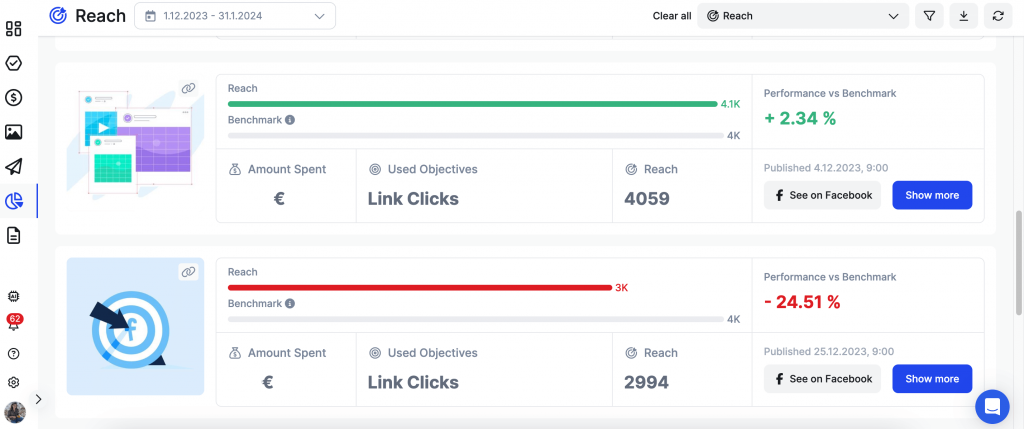Let’s get straight to the point: navigating social media by instinct alone isn’t enough if you aim to truly stand out.
I understand that audits of any kind can seem daunting, but a detailed social media audit can seriously boost your strategy.
It’s about diving deep to uncover what truly resonates, identifying where you lag behind the competition, and discovering opportunities for growth.
The good news is: that we’re about to guide you through conducting your own audit, complete with a free social media audit template to get you started. Ready to dive in?
How to conduct a social media audit in 7 steps?
Conducting a social media audit requires a structured approach to understand and refine your online presence. Here’s a step-by-step guide to help you with your social media audit.
1. Review all social media profiles used by the business
Kick off by evaluating every social media profile your business uses. The goal? Uniformity. Your branding should be consistent across all social media platforms.
Make sure you’re not using the old version of your logo on your company’s social media channels. You might want to review your bios and visual themes.
This isn’t just about looking good; it’s about making your brand recognizable and trustworthy to your audience, no matter where they find you.

Did you find some older testing profiles that can be deleted?
While you’re going through your social profiles, don’t forget to review who has access to them. Maybe some of the people left your company? It’s crucial to regularly check who can post and interact with your audience.
Keeping your list of account handlers up-to-date prevents any outdated or off-brand messaging from slipping through. It’s not just a security measure; it’s smart branding.
2. Evaluate the performance of your social media content
An important part of your social media audit is evaluating your content with a fresh lens.
Now’s the time to use social media analytics tools. These are your best friends for uncovering which content types are your MVPs in terms of engagement, reach, and conversions.

The real trick is spotting trends in your top-performing content.
This step is about smart observation. Are listicles your secret weapon, or do personal stories from your team drive more interaction?
Pinpointing these trends isn’t just insightful—it’s foundational for your next moves. It equips you with the intel to craft your future content with precision, based on what your audience actually enjoys and responds to.
After all, shaping your content strategy isn’t about guesswork; it’s about informed decisions that align with your audience’s preferences and behaviors.
What should you pay attention to when analyzing your best-performing social media content:
- Reach among your target groups: Know how far your content is going and if it’s actually reaching the segments of your audience you most want to engage.
- CTR, CPC, CPS – what kind of content delivers measurable results: Analyze which content not only captures attention but drives action, be it through clicks, conversions, or shares, and understand the cost implications of these interactions.
- Engagement rate and its quality: Beyond just tallying likes and shares, assess the depth of interaction with your content. Is it sparking conversations? Are people reacting to it in a meaningful way?
- Proportion of and stats for each type of content in your strategy: Evaluate your content mix. What balance of videos, articles, images, and other content types are you publishing, and how is each category performing?
- Generated traffic to external websites, if relevant: If driving traffic is a goal, measure how effectively your social media content is funneling users to your website or other external pages.
- The best-performing posts: Highlight your top content. These are your benchmarks, the high performers that set the standard for what success looks like on your social media channels.
3. Analyze Audience Engagement
Diving into audience engagement isn’t just about counting likes and shares on your social media channels.
It’s more nuanced, especially when you’re trying to figure out if those new followers are genuinely interested in your brand or just passing by.
Numbers can often look great on paper—more followers, more engagement—but it turns out, a chunk of that audience isn’t really connected to what the brand is all about. That’s why performing social media audits regularly is key.
First off, look at the engagement metrics and follower demographic data closely. This isn’t just about quantity; it’s about quality.
Are these people your target audience – potential customers? Do they engage in a way that suggests they’re interested in what you’re offering, or are they just there for a quick like and then disappear?
Adjusting your communication to resonate with your true target audience can make a world of difference. Tailor your content to speak their language, to address their needs and interests.
And don’t forget about your paid campaigns. This is where targeting is everything.
You might find through your audit that you’re spending cash reaching out to people who, well, just aren’t that into you.
Refining the targeting of your social media ads ensures your investment goes towards engaging the right segments, those who are more likely to convert.
Remember, your target audience is out there; it’s just a matter of fine-tuning your strategies to reach them.
4. Perform a quick competition analysis
Even if you’re pressed for time, allocating a bit of it to scope out the competition can reveal a goldmine of insights. You need to know what your competitors are doing to understand your position better.

A quick peek at their social media can tell you loads without needing to deep dive into a full-blown audit. Here’s your checklist:
- Tone of voice and communication: How are they talking to their audience? Is it formal, laid-back, or somewhere in between? This gives you a hint about the brand personality they’re projecting.
- Published content: Glance through what they’re posting. What types of content are they leaning on? Videos, user-generated content, infographics? It’s about seeing what they prioritize.
- Performance: You don’t need to focus on all the metrics, but do take note of visible stats like engagement rates or share counts. It’s a quick way to gauge what’s resonating with their audience.
- Posting frequency: This can tell you a lot about their content strategy and how active they are in keeping their audience engaged.
- Community management patterns: Notice how they interact with their audience. Are they prompt in replying, or is it more of a one-way communication street?
Remember, the goal isn’t to copy what your competitors are doing but to understand the landscape. It’s about identifying opportunities they might be missing, strategies that are working (that you might not be using), and areas where you can truly differentiate.
5. Set new goals, objectives, and action items
After combing through your social media presence, it’s like you’ve got a map in your hands now. You know where you’ve been hitting the mark and where things have been falling flat.
Setting new goals isn’t about shooting in the dark; it’s about precision. For each social media platform, you want to lay down clear, measurable goals.
Think “increase Instagram engagement rate by 10% within the next quarter” rather than “get more likes.” This clarity makes tracking progress straightforward and keeps everyone on the same page.
But it’s not just about setting targets. You’ve got to strategize on how to hit them.
Pinpointed a dip in engagement? Maybe it’s time to mix things up in your content strategy, introduce more interactive posts, or experiment with reels or live sessions.

Found your growth stalling? Explore partnerships or influencer collaborations to get in front of new eyes. Each goal needs specific actions tailored to bridge the gap between where you are and where you want to be.
Regularly revisiting your goals and strategies keeps you agile, and ready to pivot whenever necessary.
6. Perform a SWOT analysis
Jumping into a SWOT analysis is like putting your social media strategy under a microscope. This isn’t just busy work; it’s a strategic move to identify exactly where you stand and where you could be heading. Here’s how it breaks down:
- Strengths: Kick things off by spotlighting what you’re nailing on social. Maybe your engagement rates are through the roof, or your follower growth is steady and strong. These are your aces, the core of your strategy that you’ll want to keep building on.
- Weaknesses: Now, let’s get real about the areas where you’re not quite hitting the mark. Is your content not as consistent as it could be? Maybe your reach isn’t expanding as you’d hoped? Identifying these gaps is your first step toward tightening up your game.
- Opportunities: This is where you get to dream a bit. Based on current trends and the gaps you’ve identified, what untapped potential can you lean into? Maybe there’s a platform you’ve overlooked or a content style you haven’t explored yet.
- Threats: Finally, consider what external factors could throw a wrench in your plans. This could be anything from algorithm changes to emerging competitors vying for your audience’s attention.
7. Establish New Objectives and Action Items
In essence, turn the insights from your social media audit into a roadmap for the future.
Break down each objective into smaller tasks, assign them to team members, set deadlines, and most importantly, keep track of progress.
This isn’t just about planning; it’s about execution and adaptation.
Setting new objectives and action items is your chance to refine your social media strategy, ensuring it’s not only responsive to the current landscape but also poised for future growth.
Social media audit template
Conducting a good social media audit so quickly is quite a challenge.
As we love helping you manage your social media, we decided to create a cheat sheet that should allow you to evaluate your social media performance in half an hour.
Frequently Asked Questions about Social Media Audit
How long does a social media audit take?
The time frame for social media audits isn’t set in stone. It really depends on how many accounts you’re juggling and how deep you want to dive into the analytics. Generally, you’re looking at a few hours to a couple of days.
How can a social media audit improve business ROI?
Social media audits shine a spotlight on what’s working and what’s not. By pinpointing the content that resonates most with your audience and refining your social media strategy accordingly, you can boost engagement, drive more conversions, and, ultimately, see a healthier return on investment. It’s about smartening up your social game to see real gains.
What should be included in a social media content audit?
When you’re auditing your content, make sure to cover all bases: how different types of content are performing, what’s getting people talking, and how often your posts are hitting the mark. It’s about gathering a mix of content performance metrics, engagement rates, and a breakdown of content types to get a clear picture of your social media health. Download our free social media audit template, which will be enough to get you started.
How would you perform a social media audit?
Kick things off by gathering all your social media accounts in one place. Then, dive into the analytics to assess how your content’s been performing and how your audience is engaging with it. Don’t forget to do a SWOT analysis to identify strengths, weaknesses, opportunities, and threats. Wrap up by setting some sharp, actionable goals based on what you find. It’s a bit like detective work, piecing together clues to form a clearer strategy for your social media presence.
Use your social media audit findings to get the most out of your strategy
Performing a social media audit is a critical step in refining your strategy to ensure it aligns with business goals and audience expectations. By using the right tools and adopting a structured approach to analyze content performance and audience engagement, businesses can set new objectives and action items that propel their social media efforts toward greater success and ROI.





